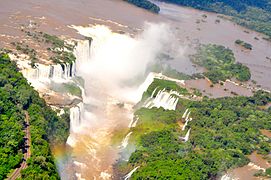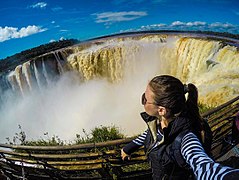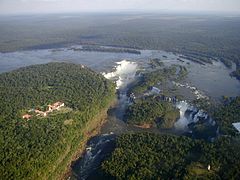Monday, November 18, 2019, Iguazu Falls, Argentina

Buenos Aires is the capital and largest city of Argentina. The city is located on the western shore of the estuary of the Río de la Plata, on the South American continent's southeastern coast. "Buenos Aires" can be translated as "fair winds" or "good airs," but the former was the meaning intended by the founders in the 16th century, by the use of the original name "Real de Nuestra Señora Santa María del Buen Ayre." The Greater Buenos Aires conurbation, which also includes several Buenos Aires Province districts, constitutes the fourth-most populous metropolitan area in the Americas, with a population of around 15.6 million.
The city of Buenos Aires is neither part of Buenos Aires Province nor the Province's capital; rather, it is an autonomous district. In 1880, after decades of political infighting, Buenos Aires was federalized and removed from Buenos Aires Province. The city limits were enlarged to include the towns of Belgrano and Flores; both are now neighborhoods of the city. The 1994 constitutional amendment granted the city autonomy, hence its formal name: Autonomous City of Buenos Aires. Its citizens first elected a chief of government (i.e. mayor) in 1996; previously, the mayor was directly appointed by the President of the Republic.
Buenos Aires is considered an 'alpha city' by the study GaWC5. Buenos Aires' quality of life was ranked 91st in the world, being one of the best in Latin America in 2018. It is the most visited city in South America, and the second-most visited city of Latin America (behind Mexico City).
Buenos Aires is a top tourist destination, and is known for its preserved Eclectic European architecture and rich cultural life. Buenos Aires held the 1st Pan American Games in 1951 as well as hosting two venues in the 1978 FIFA World Cup. Buenos Aires hosted the 2018 Summer Youth Olympics and the 2018 G20 summit.
Buenos Aires is a multicultural city, being home to multiple ethnic and religious groups. Several languages are spoken in the city in addition to Spanish, con-tributing to its culture and the dialect spoken in the city and in some other parts of the country. This is because in the last 151 years the city, and the country in general, has been a major recipient of millions of immigrants from all over the world, making it a melting pot where several ethnic groups live together and being considered one of the most diverse cities of the Americas.

Iguazú Falls
Iguazú Falls or Iguaçu Falls are waterfalls of the Iguazu River on the border of the Argentine province of Misiones and the Brazilian state of Paraná. To-gether, they make up the largest waterfall system in the world. The falls divide the river into the upper and lower Iguazu. The Iguazu River rises near the heart of the city of Curitiba. For most of its course, the river flows through Brazil; however, most of the falls are on the Argentine side. Below its confluence with the San Antonio River, the Iguazu River forms the boundary between Argen-tina and Brazil.
The name "Iguazú" comes from the Guarani or Tupi words "y," meaning "water," and "ûasú "[waˈsu], meaning "big." Legend has it that a deity planned to marry a beautiful woman named Naipí, who fled with her mortal lover Tarobá in a canoe. In a rage, the deity sliced the river, creating the waterfalls and con-demning the lovers to an eternal fall. The first European to record the existence of the falls was the Spanish Conquistador Álvar Núñez Cabeza de Vaca in 1541.
The staircase character of the falls consists of a two-step waterfall formed by three layers of basalt. The steps are 115 and 131 feet in height. The columnar basalt rock sequences are part of the 300 feet Serra Geral Formation within the Paleozoic-Mesozoic Paraná Basin. The tops of these sequences are characterized by 26–33 feet of highly resistant vesicular basalt and the contact between these layers controls the shape of the falls. Headwater erosion rates are estimated at 0.55–0.83 inches/year.
The Iguazu Falls are located where the Iguazu River tumbles over the edge of the Paraná Plateau, 23 14 miles upriver from the Iguazu's confluence with the Paraná River. Numerous islands along the 1.7 mile-long edge divide the falls into many separate waterfalls and cataracts, varying between 197 and 269 feet high. The number of these smaller waterfalls fluctuates from 150 to 300, depending on the water level. About half of the river's flow falls into a long and narrow chasm called the Devil's Throat.
The Devil's Throat canyon is 260–300 feet wide and 230–260 feet deep. Left of this canyon, another part of the river forms 160-200 individual falls, which merge into a single front during flood stage. The largest falls are named San Martín, Adam and Eva, Penoni, and Bergano.
About 2,950 feet of the 1.7 miles length does not have water flowing over it. The water of the lower Iguazu collects in a canyon that drains into the Paraná River, a short distance downstream from the Itaipu Dam. The junction of the water flows marks the border between Brazil, Argentina, and Paraguay. Some points in the cities of Foz do Iguaçu, Brazil, Puerto Iguazú, Argentina, and Ciudad del Este, Paraguay, have access to the Iguazu River, where the borders of all three nations may be seen, a popular tourist attraction for visitors to the three cities.
https://en.wikipedia.org/wiki/Iguazu_Falls
We flew from Buenos Aires to Iguazu then rode a half hour to the falls.
We boarded a train for a 20-minute ride after lunch.





Named the "Devil's Throat."



Path to second lookout point.
Monkeys!
See how close Diane is?

Second lookout point.
Lower path at second lookout.
Hotel across a valley.
Path at bottom of falls.
Hotel where we ate Supper prior to heading to the airport.
Palm trees and swim pool.
Falls from several miles away.
We flew from Buenos Aires to Iguazu then rode a half hour to the falls.





Small river feeding the falls.
About a mile walk to our first overlook.
Named the "Devil's Throat."


Waiting to board the train to our second lookout point.
Coatis, also known as coatimundis, are members of the family (Procyonidae) in the genera Nasua and Nasuella. They are diurnal mammals native to South America, Central America, Mexico, and the southwestern United States. The name coatimundi is purportedly derived from the Tupian languages of Brazil. The coati is also known in English as the hog-nosed coon.

Path to second lookout point.
Monkeys!
See how close Diane is?

Second lookout point.
Lower path at second lookout.
Hotel across a valley.
Path at bottom of falls.
Hotel where we ate Supper prior to heading to the airport.
Palm trees and swim pool.
Falls from several miles away.
Heading back to airport and Buenos Aires. It was 1:30 AM when we arrived at cruise ship.



















































Hi Larry and Diane,
ReplyDeleteEnjoy reading and viewing the wonderful sites you are visiting. You guys are missed at Flourish.
Hope your Thanksgiving day will be as thankful as we are for you two and the adventure of a lifetime.